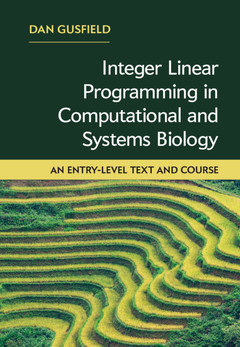Description
Integer Linear Programming in Computational and Systems Biology
An Entry-Level Text and Course
Author: Gusfield Dan
This hands-on tutorial text for non-experts demonstrates biological applications of a versatile modeling and optimization technique.
Language: English
Subject for Integer Linear Programming in Computational and Systems...:
Publication date: 06-2019
428 p. · 18.1x26 cm · Hardback
428 p. · 18.1x26 cm · Hardback
Description
/li>Contents
/li>Biography
/li>
Integer linear programming (ILP) is a versatile modeling and optimization technique that is increasingly used in non-traditional ways in biology, with the potential to transform biological computation. However, few biologists know about it. This how-to and why-do text introduces ILP through the lens of computational and systems biology. It uses in-depth examples from genomics, phylogenetics, RNA, protein folding, network analysis, cancer, ecology, co-evolution, DNA sequencing, sequence analysis, pedigree and sibling inference, haplotyping, and more, to establish the power of ILP. This book aims to teach the logic of modeling and solving problems with ILP, and to teach the practical 'work flow' involved in using ILP in biology. Written for a wide audience, with no biological or computational prerequisites, this book is appropriate for entry-level and advanced courses aimed at biological and computational students, and as a source for specialists. Numerous exercises and accompanying software (in Python and Perl) demonstrate the concepts.
Preface; Part I: 1. A fly-over introduction; 2. Biological networks and graphs; 3. Character compatibility; 4. Near-cliques; 5. Parsimony in phylogenetics; 6. RNA folding; 7. Protein problems; 8. Tanglegrams; 9. TSP in genomics; 10. Molecular sequence analysis; 11. Metabolic networks and engineering; 12. ILP idioms; Part II: 13. Communities and cuts; 14. Corrupted data and extensions in phylogenetics; 15. More tanglegrams and trees; 16. Return to Steiner-trees; 17. Exploiting protein networks; 18. More strings and sequences; 19. Max-likelihood pedigrees; 20. Haplotyping; 21. Extended exercises; 22. What's next?; Epilogue: opinionated comments.
Dan Gusfield is Distinguished Professor of Computer Science at the University of California, Davis, and a Fellow of the IEEE, the ACM, and the International Society of Computational Biology (ISCB). His previous books include The Stable Marriage Problem (1989, with Robert W. Irving), Algorithms on Strings, Trees and Sequences (Cambridge, 1997) and ReCombinatorics (2014). He has served as chair of the computer science department at UCD (2000–04), and was the founding Editor-in-Chief of the IEEE/ACM Transactions of Computational Biology and Bioinformatics until January 2009. He has been instrumental in the definition and development of the intersection between computer science and computational biology.
© 2024 LAVOISIER S.A.S.

